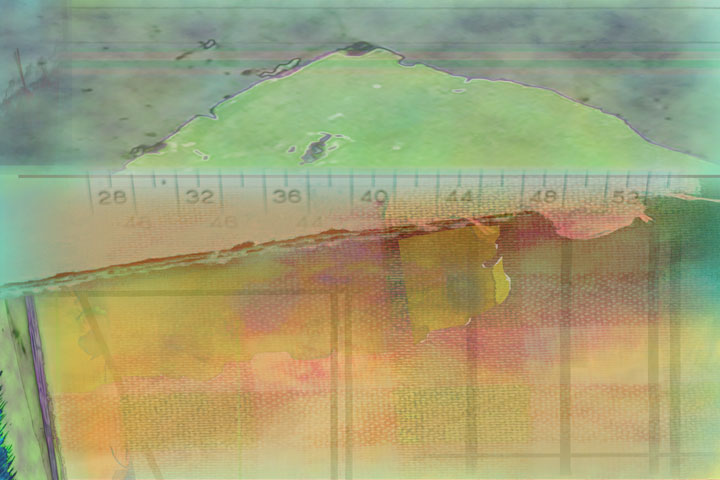Harvey’s Lake Tahoe may have been his final tormented thought.
John Birges slipped away. He was sleeping just about nonstop. Stomach pain sliced him up. Jaundice set in.
All the hallmarks of the final stage of liver cancer, all the paybacks.
Then it was over, a spring day in 1996 in a lonely room in the Southern Nevada Correctional Center.
Sixteen years and a day since his bomb went off, the largely forgotten John Birges was dead at the age of 74.
If there is such a thing as a good place to die, there’s no way this place would have come close.
Two wings of cell blocks. Two fences, the inside fence 20-foot-tall chain link topped off with razor wire. The outer one armored with double rolls of razor wire up top and another roll spread out along the ground.
No shrubs or bushes or trees, just gravel. Nothing much to look at other than the McCullough Mountains off to the southeast.
Life without parole was the sentence for John Birges, as bizarre a man as ever set foot in Nevada, full of lies and hatreds and complexities.
A violent man, at one time a millionaire, clever and devious.
…
On August 26th, 1980, Terry Lee Hall and his father-in-law, Willis Brown parked a white van with an IBM logo outside Harvey’s Lake Tahoe. They’d been sent by John Birges.
Early in the morning the two men in white jumpsuits wheeled what was designed to be mistaken for a photocopy machine across the parking lot. A cloth with a sloppily stenciled IBM logo draped over the machine.
A helpful security guard held the door open. Terry Lee Hall and Willis Brown proceeded into the casino and up an elevator to the second floor.
Nobody gave the delivery a second thought. Not until hours later when a slot manager working graveyard told casino security about the tampered locks he’d spotted.
…
Cloaked by the sheet cloth imprinted with the crude IBM logo was one of the most elaborate bombs the FBI had ever encountered. The big metal box presented a blend of complexity and simplicity. A manic testament to the ingenuity of a demented man bent on revenge, determined to balance what he saw as unfairly lopsided scales.
The vicious heart of the device, a half-ton of dynamite stolen from a construction site at the Helms Pumped Storage Plant in California and hauled up to Lake Tahoe.
It didn’t take long for FBI experts to show up. On the second floor of Harvey’s Lake Tahoe they encountered a savage device wired up in ways they’d never seen.
It was designed with taunting complexity. Strange circuits and ambiguous passageways snaking up and down the back alleys of its creator’s devious mind.
Working alone in his garage, John Birges had assembled a deadly game of chutes and ladders where any one of a number of wrong decisions meant detonation and certain destruction.
Nobody in the Bureau had ever come across anything like it. For years to come, the FBI used a model of the bomb that tore a five-story hole out of the side of Harvey’s Lake Tahoe to train agents.
…
The typed ransom letter came delivered with the bomb.
It demanded $3 million from Harvey’s in used hundred-dollar bills. The note made it clear the device could not be disarmed. Instructions on how to maneuver the switches on the device would be provided only after the ransom was delivered. Only then could the FBI move the bomb and detonate the device remotely.
Federal agents dispatched to Lake Tahoe late that summer of 1980 soon knew what they were up against.
But they didn’t know quite enough. The feds brought in X-ray gear to study the bomb. They determined moving the device would be too risky. It would have to be disarmed in the hotel.
So they closed the casino. Roulette wheels stopped spinning. Cards were no longer dealt. Slot machines were shut down. Every employee, every guest evacuated, many of the guests sent to the George Whittell High School in nearby Zephyr Cove.
They shut off the gas main and they kept looking for answers. For an entire day they studied the bomb. They knew from the ransom letter even the slightest movement, the smallest shock would detonate the device. Eventually they figured their best shot was to somehow separate the detonators from the half ton of dynamite.
It wasn’t just that half ton of dynamite but the overawing complexity of the device.
Attached to small lengths of wood were 28 toggle switches. The switches controlled eight separate fusing systems. One controlled an anti-motion device. Others controlled a timer and a float mechanism.
The way the flat head screws on the perimeter of the metal box were attached to wires and contacts inside, the device would detonate if any of the screws were turned. The bomb built by John Birges would also go off if neoprene and aluminum layered inside the box was penetrated with a drill.
Inside the big metal box, a shaft of PVC pipe, lined with aluminum foil, had a bolt hanging inside it. If the bomb was tilted, the bolt would make contact and detonate the device.
It seemed every possible method of disarming the bomb had been considered. If technicians flooded the innards of the metal box to disable it, a toilet float would lift up, make contact and set it off.
The gameplan eventually settled on was to separate the detonators from the half ton of dynamite with a shaped charge of C-4.
It didn’t work.
FBI technicians hadn’t identified a second cluster of dynamite packed into a separate box atop of the device. This box housed an independent detonation circuit.
When the C4 took out the detonation circuit, it set off this second small cache of dynamite, which in turn detonated the entire device.
…
The way John Birges saw it, he had more than enough good reasons to build the bomb. After all, Harvey’s Lake Tahoe wouldn’t let him play in the high roller suite anymore.
He was an immigrant from Hungary with a violent temper and a shadowy past. Claims he flew missions for the German Luftwaffe in World War II were never substantiated.
But Birges did fly missions against the Soviets during the Russian occupation of his native Hungary.
With his wife Elizabet he landed in Clovis, California in 1957. Birges went to work in a steel manufacturing plant, moved on to build a successful landscaping business and owned a restaurant. He was violent and unstable. His wife suffered savage beatings, divorced him and soon after took her life.
About that time his restaurant burned down.
And that was when John Birges started making trips to Nevada. He became a regular at Harvey’s Lake Tahoe. Long stretches at the blackjack table were partially funded with the $355,000 insurance settlement. On top of that bounty he dropped another $400,000 at Harvey’s.
When the money was gone, so was John Birges. Back to Clovis, California to work on a project in his garage.
…
Other casinos in town took book on when the bomb would explode.
It went off at 3:43 PM. Crowds in the street pressed up against barricades. Tourists cheered when Harvey’s Lake Tahoe thundered and a wall crumbled, but the structure still stood, despite the 45,000-foot ton force of a half-ton of dynamite.
Mangled slot machines hurtled out of the casino and crashed onto Lake Tahoe Boulevard.
So did chunks of cement and spears fashioned from the iron railings of balconies. Steel beams soared through the warm afternoon and crashed down into parking lots. Across the street windows shattered at Harrah’s.
A celebratory mood washed over the barmy crowd. They jammed the street outside the neighboring El Dorado Motel and the Blu Jay Motor Inn. When the smoke cleared, they saw a five-story hole carved out of the 11-story building.
What they couldn’t see at Harvey’s Lake Tahoe were several fortunes, temporarily astray and unaccounted for.
Mixed in with the rubble on the floor of the casino were millions of dollars’ worth of chips from cashiers’ cages and coins from slot machines. In the days ahead, FBI agents would sift through the detritus and hand them back to Harvey’s.
A section of the casino left unscathed by the blast quickly reopened. Curious gamblers could look through a big window and watch FBI investigators dig through the rubble for clues.
…
Harvey Gross launched what would become Harvey’s Lake Tahoe in a mock log cabin in 1944.
His place featured three slot machines, two card tables, a six-stool snack bar and a 24-hour gas station.
Harvey was a meat wholesaler from Sacramento. His Tahoe troubles with the IRS began in 1957 when he was indicted by a federal grand jury on tax charges.
He opened the 11-floor hotel in 1963 and seventeen years later, shortly after John Birges’s bomb slashed it with a fifty-foot gash, Harvey Gross broke into tears.
Harvey Gross was overheard saying, “Thank God we didn’t hurt anyone.”
…
John Birges found out the hard way.
The toughest part of the caper is collecting the ransom.
He designed a random drop-off as meticulously as he designed his bomb. Or so he thought. The ransom letter demanded a helicopter flown by a single unarmed pilot with $3 million onboard. It was to land at the Lake Tahoe Airport.
The pilot chosen was an FBI special agent. And the three canvas bags on the copter weren’t exactly packed with $3 million. The only unmarked twenties, reluctantly provided to the FBI by Harvey Gross, were piled on top of wads of paper cut in the shape of currency.
Around midnight the pilot refueled the copter at the Lake Tahoe Airport. Then he walked to a designated payphone. When it rang, he was told the instructions for what to do next were taped to the bottom of the payphone booth’s small table.
The typewritten message instructed him to fly west for 15 miles and follow the route of U.S. Highway 50. The letter said near Echo Summit there would be a strobe light down in the woods. It would beam up from a clearing and signal where to land.
But there wasn’t a strobe light down in the woods. The copter never landed.
The pilot circled over the forest for an hour, staring down into elliptical darkness. Then he flew back to the Lake Tahoe Airport. A team of FBI agents waited by the payphone in the event there might another call.
There wasn’t.
…
At two in the morning, Nevada Governor Robert List answered his bedside phone. It was the FBI. Would the Governor make a public appeal to the extortionists?
The Governor started his day early by issuing a strange message, an announcement that would be cryptic for the public but obvious to John Birges.
Governor List asked the extortionist to get in touch with the FBI. He said there would be another attempt to pay the ransom.
John Birges didn’t get the message. Not at first.
He and his 18-year-old son, Jim, spent the night shivering in the mountains. They were in a clearing just off Ice House Road, not far from the South Fork of the American River in the Eldorado National Forest.
Both of them had underestimated how chilly the mountains could be, even in late summer. To get a fire going for some warmth, they took bullets apart and removed gunpowder from the casings.
It eventually dawned on them that the copter with the cash wasn’t coming.
The same thought dawned on John Birges Jr., parked in his father’s Volvo 20 miles south off Highway 88 in Amador County.
What John Jr. had been waiting for never happened. His father never piloted the copter overhead. The cash never dropped.
Before daylight, John Jr. drove to the Cameron Park Airport. That’s where his father’s girlfriend, Ella Williams, had been waiting for John Sr. to land the copter after the planned drop.
Ella told John Jr. she’d heard the message from Governor List. The two drove back toward Tahoe, to where John Sr. and Jim were still huddled off Ice House Road.
It was not an uneventful drive.
John Jr. hit a deer. Ella sailed off a hairpin curve and slammed headfirst into the windshield when her Toyota crashed into the wall of a mountain.
The four of them left Ice House Road and headed west on Highway 50. Ella looked to be in rough shape, conscious but bleeding badly. They dropped her off at the hospital in Placerville where she was treated for facial contusions and a bloody nose.
Not far from the hospital, the Volvo with the big dent in the fender from hitting the deer pulled into a Beacon gas station. From a payphone, John Jr. gave the Douglas County Sheriff’s Office in Stateline a call. He told the dispatcher to tell the FBI to throw switch number 5 on the bomb and wait for more instructions.
Switch 5 was window dressing. It served no function other than to buy John Birges some time.
They pulled out of Placerville, the morning’s first light in the sky behind them and headed back down to Clovis. They picked up a speeding ticket on the way. John Jr. went to work. John Sr. and Jim barreled back up to Placerville in Jim’s red Toyota pickup to pick up Ella at the hospital.
That’s when they heard the top of the hour news on the radio.
The bomb had gone off.
…
It took almost a year for the FBI to track down John Birges.
Textbook legwork and door knocking, interviews with hundreds of suspects, hundreds of witnesses and finally, a break from the lady who owned the Balahoe Motel in South Lake Tahoe.
Nancy De Minico told them about the three men who stayed at her place the night before the bomb went off. If one of them hadn’t made such lewd comments, she probably wouldn’t have written down the license plate number on their white van.
That’s what led the feds to Clovis. But what the FBI agents found at the Birges house didn’t line up with their profiling.
Five people living in a messy home, empty cases of beer stacked, bags of pot scattered around. Not at all congruent with the meticulous and disciplined behaviors of whoever built that bomb. John Birges couldn’t be their man.
And he wasn’t their man until a tip came in.
Motivated by the offer of a reward, the tip came from the current boyfriend of the ex-girlfriend of John Jr. He had done a little too much talking.
When the FBI caught him lying about his whereabouts the previous August 26 and 27 and began to explain how much time he’d spend in prison, John Jr. was sufficiently motivated to roll over on his father.
…
Birges got life without parole. His two boys cut a deal that kept them out of jail. The two men who wheeled the bomb into Harvey’s Lake Tahoe served time.
Ella Joan Williams, who plowed her Celica into the side of a mountain on Ice House Road, was convicted of attempted extortion, conspiracy and interstate travel in aid of extortion.
If she hadn’t typed the demand letter, things may have worked out better for her.
…
Harvey’s Lake Tahoe still stands. It is now owned by a New York-based Real Estate Investment Trust, Vici Properties, operated by Caesars Entertainment.
The Southern Nevada Correctional Center is gone.
Just west of Riverton, California on US 50, motorcycles still turn off onto Ice House Road.
They glide past the spot where John Birges waited for the copter and the cash that never came.






